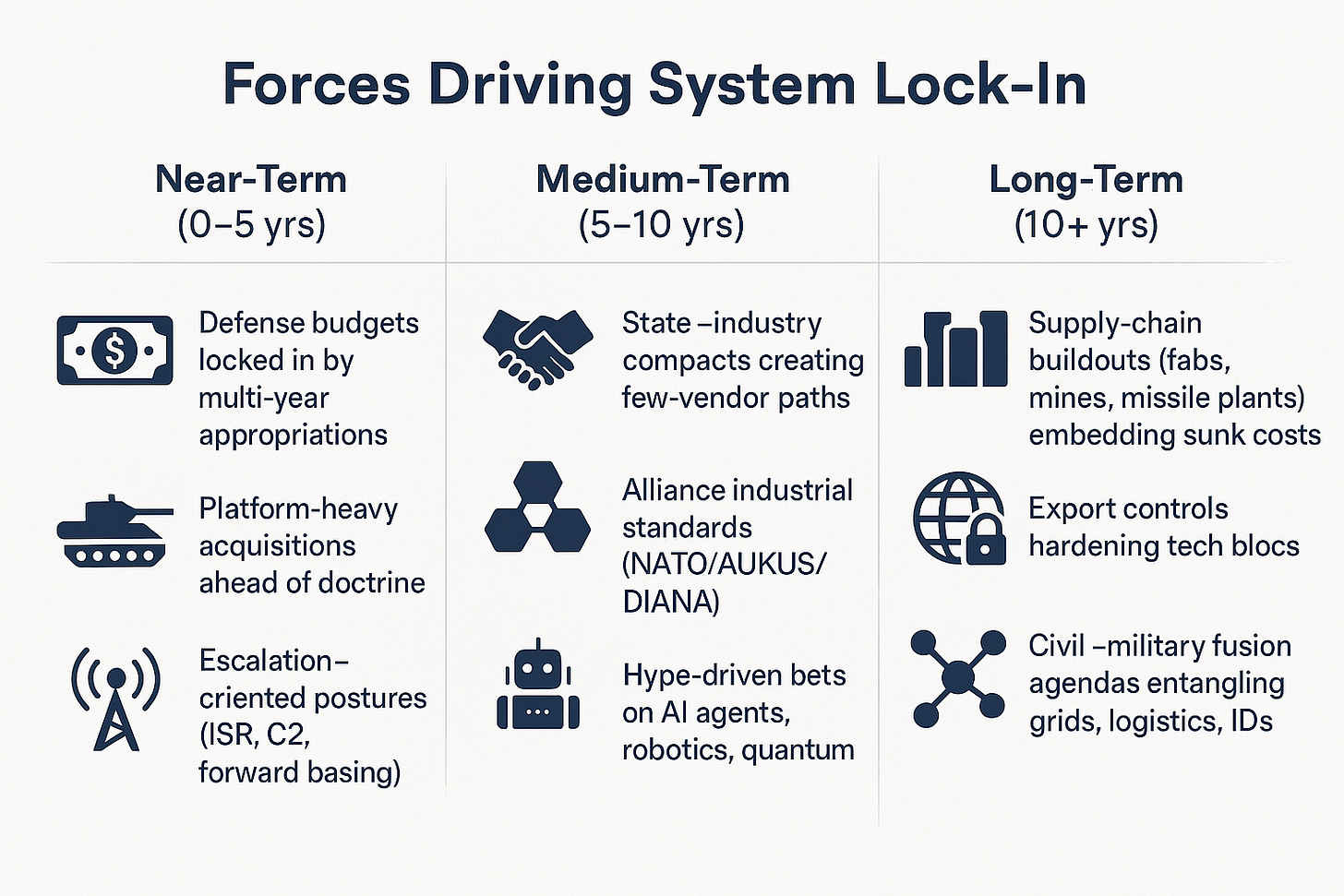System Lock-In
Today’s Choices, Tomorrow’s Limits
The surge in military and defence spending, sprawling state–industry partnerships, and the rush to embed new technologies are hardening today’s choices into tomorrow’s limits. As architectures, supply chains, and alliances become fixed around current assumptions, they narrow room to question force design, acquisition paths, escalation postures, and even how civilian economies interact with security aims. This was the perspective I shared during NATO’s Strategic Foresight Analysis discussions last week in Virginia.
Without conscious design, these interlocked systems may lock decision-makers into sustaining costly capabilities, privileging a handful of vendors, or escalating crises along predetermined rails, leaving less space to adapt once the machinery of policy and force begins to gather its own momentum.
Across current programs, we see how today’s defence choices are hardening into tomorrow’s constraints. The F-35’s escalating cost curve and production momentum illustrate how multi-year budgets and sunk investments create political gravity around a single platform. China’s civil–military fusion policies are weaving commercial logistics, satellites, and AI firms directly into PLA force design, making separation nearly impossible. Taiwan Semiconductor Manufacturing Company (TSMC)’s massive U.S. chip build-out shows how supply-chain sovereignty efforts create long-term industrial anchors, even when efficiency falters. Layer onto that the race to deploy AI-enabled command platforms, and the sunk costs in data infrastructure, model training, and coalition agreements and you get path dependencies that extend far beyond technology. They start to define theories of victory, deterrence postures, and alliance architectures long before leaders can fully test alternatives or build deliberate off-ramps.
Signals I’m Tracking
Below are the pressures I see converging to produce this lock-in:
Record defence budgets – multi-year appropriations tying governments to long procurement tails.
State–industry compacts – formal “national champions,” subsidy regimes, and sovereign-tech programs that privilege fixed suppliers.
Platform-centric acquisitions – large, exquisite systems purchased faster than doctrine or governance can adapt.
Long supply-chain buildouts – rare-earth mining, chip fabs, missile plants, and quantum labs whose sunk costs anchor strategy.
Alliance industrial policies – co-funding and shared production creating path-dependent standards.
Security-justified export controls – walls around AI, quantum, and hypersonic tech that entrench blocs and limit recombination.
Emergent tech hype cycles – urgent pushes on AI agents, robotics, space-to-sea kill chains, or quantum comms shaping force design before testing assumptions.
Civil-military fusion agendas – blending civilian logistics, energy grids, and digital IDs with defence aims, shrinking options to separate them later.
Escalation-oriented postures – forward basing, integrated C2, and persistent ISR that default toward rapid response rather than pause or retreat.
Strategic Decisions at Risk
An entrenched AI decision-making system could shape and potentially freeze the highest-level choices about war:
Theory of victory – privileging algorithmic speed and prediction over endurance, deception, or political leverage.
Civil–military balance – embedding military AI into national digital infrastructure, shrinking space for civilian oversight or alternative policy tools.
Alliance architecture – fixing which states share data, models, and compute, shaping future coalition boundaries and dependencies.
Deterrence posture – normalizing automated early-warning and response chains, raising pressure to act first in crises.
Resource strategy – steering decades of budgets toward compute, networks, and data centers rather than diplomacy, resilience, or social capacity.
Escalation philosophy – codifying pre-delegated responses or “always-on” surveillance, biasing leaders toward rapid contest instead of pause or negotiation.
Industrial model of war – committing to vertically integrated defence-tech complexes, limiting space for modular, adaptive alternatives if the character of conflict shifts.
The Foresight Challenge
Lock-in is not inevitable, but avoiding it demands foresight: building off-ramps, testing alternative pathways, and designing governance that can evolve as strategy and technology do. The question is not only how to integrate AI and new defence tools, but how to preserve freedom to re-think the assumptions behind them before the systems we build start making decisions for us.


